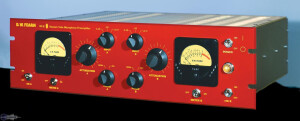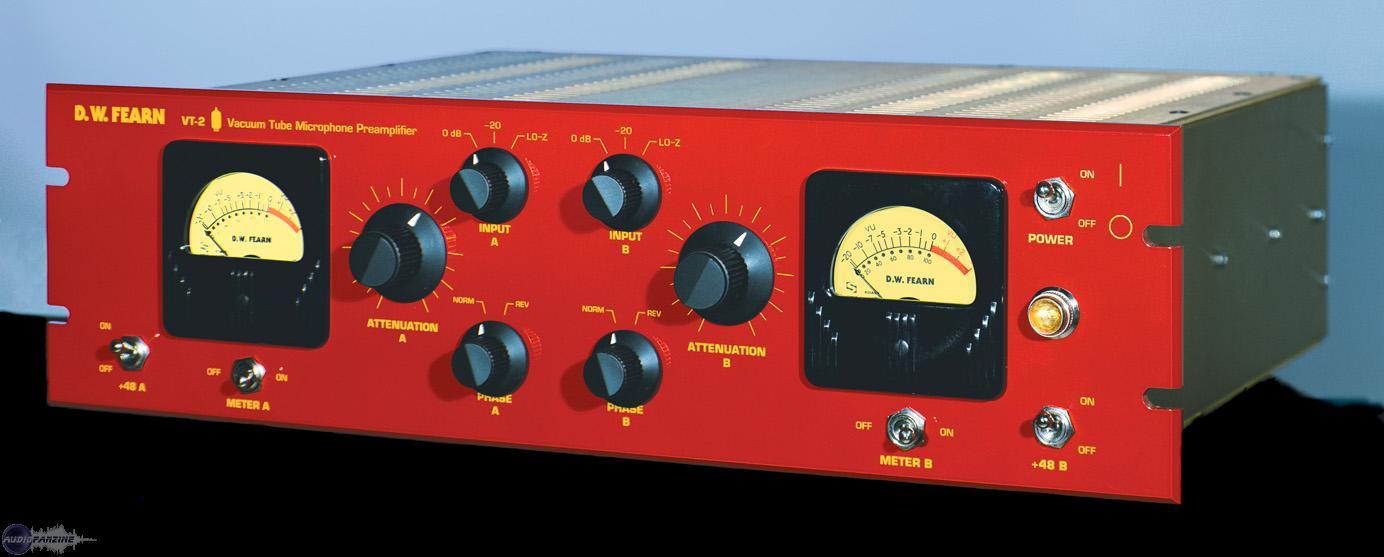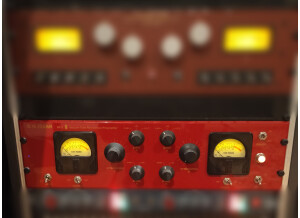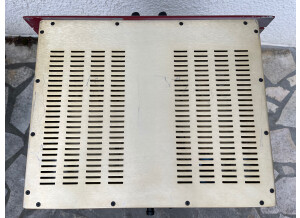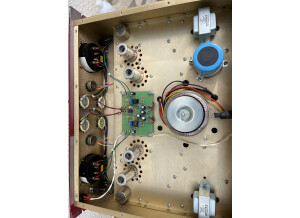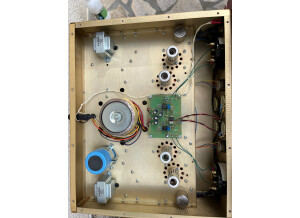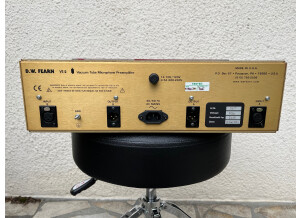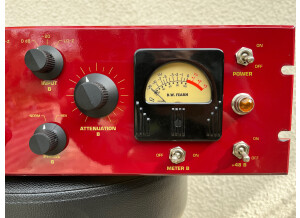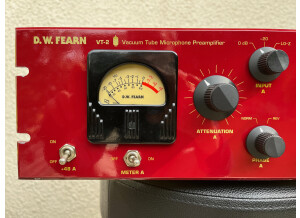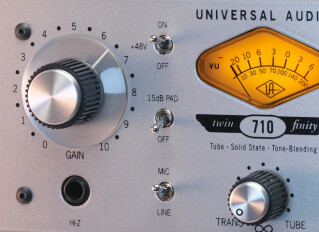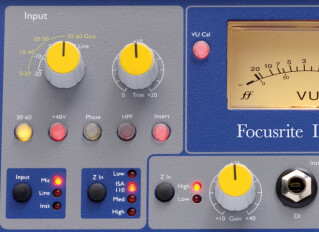VT-2 classified ad
Alerte nouvelle annonceImages
Reviews
5.0/5(4 reviews)
50 %
Write a user review
Expensive but fabulous new tube preamp
Published on 06/24/10 at 12:38This is a tube preamp, but using modern technology, it does sound a little different from the classic tube preamps. This has two preamps on it, both of which have the same controls. It needs to be put into a racked unit to work, and you need to either plug directly into it or have it set up in your patch bay to work.
UTILIZATION
The editing on this pre-amp isn't much different than most pre-amps. For each channel, It has an attenuation (input gain) knob. phantom power (+48v), a -20db pad, and phase reverse. Each channel also has an input (Lo-Z) that is designed to perform well with transformerless mics. The manual will explain everything about this pre-amp in detail, and the customer...…
UTILIZATION
The editing on this pre-amp isn't much different than most pre-amps. For each channel, It has an attenuation (input gain) knob. phantom power (+48v), a -20db pad, and phase reverse. Each channel also has an input (Lo-Z) that is designed to perform well with transformerless mics. The manual will explain everything about this pre-amp in detail, and the customer...…
Read more
This is a tube preamp, but using modern technology, it does sound a little different from the classic tube preamps. This has two preamps on it, both of which have the same controls. It needs to be put into a racked unit to work, and you need to either plug directly into it or have it set up in your patch bay to work.
UTILIZATION
The editing on this pre-amp isn't much different than most pre-amps. For each channel, It has an attenuation (input gain) knob. phantom power (+48v), a -20db pad, and phase reverse. Each channel also has an input (Lo-Z) that is designed to perform well with transformerless mics. The manual will explain everything about this pre-amp in detail, and the customer service that comes with D.W. Fearn products is very good.
SOUND QUALITY
This preamp has a great sound to it. It doesn't color the sound too drastically, although it isn't completely transparent. However, most of the time you don't want something completely transparent anyway, mainly because it'd be a dull sound. The Fearn sounds particularly good with low end instruments like bass and kick drums, but it can be used for all instruments well. It does a particularly good job of bringing out a full, round sound and emphasizing the favorable frequencies.
OVERALL OPINION
I like the sound of this preamp the best. I haven't had the chance to use the Lo-Z input yet, but I look forward to it. The phase reverse and phantom power work fine, and the pad is useful. There isn't much more to say, other than this is a great tube pre-amp with a few modern touches thrown in for good measure.
UTILIZATION
The editing on this pre-amp isn't much different than most pre-amps. For each channel, It has an attenuation (input gain) knob. phantom power (+48v), a -20db pad, and phase reverse. Each channel also has an input (Lo-Z) that is designed to perform well with transformerless mics. The manual will explain everything about this pre-amp in detail, and the customer service that comes with D.W. Fearn products is very good.
SOUND QUALITY
This preamp has a great sound to it. It doesn't color the sound too drastically, although it isn't completely transparent. However, most of the time you don't want something completely transparent anyway, mainly because it'd be a dull sound. The Fearn sounds particularly good with low end instruments like bass and kick drums, but it can be used for all instruments well. It does a particularly good job of bringing out a full, round sound and emphasizing the favorable frequencies.
OVERALL OPINION
I like the sound of this preamp the best. I haven't had the chance to use the Lo-Z input yet, but I look forward to it. The phase reverse and phantom power work fine, and the pad is useful. There isn't much more to say, other than this is a great tube pre-amp with a few modern touches thrown in for good measure.
See less
20
»
Published on 12/11/08 at 17:18
(Originally written by Querelle/translated from Audiofanzine FR)
Nice-looking unit (just look at the picture, although it's even better when you have it in front of you). The thick metal front with beveled edge and blood red finish looks wonderful. The big black controls and the two VU-meters give it a sculptural look.
Let's talk about the objective description starting with noise. The noise of a preamp is measured in noise level referred to an input (or Equivalent Input Noise, EIN) which is the output noise level minus preamp gain. It's logical otherwise a low gain would be enough to specify a low noise level... If the VT2 fully tuned up seems to generate less noise than...…
Nice-looking unit (just look at the picture, although it's even better when you have it in front of you). The thick metal front with beveled edge and blood red finish looks wonderful. The big black controls and the two VU-meters give it a sculptural look.
Let's talk about the objective description starting with noise. The noise of a preamp is measured in noise level referred to an input (or Equivalent Input Noise, EIN) which is the output noise level minus preamp gain. It's logical otherwise a low gain would be enough to specify a low noise level... If the VT2 fully tuned up seems to generate less noise than...…
Read more
(Originally written by Querelle/translated from Audiofanzine FR)
Nice-looking unit (just look at the picture, although it's even better when you have it in front of you). The thick metal front with beveled edge and blood red finish looks wonderful. The big black controls and the two VU-meters give it a sculptural look.
Let's talk about the objective description starting with noise. The noise of a preamp is measured in noise level referred to an input (or Equivalent Input Noise, EIN) which is the output noise level minus preamp gain. It's logical otherwise a low gain would be enough to specify a low noise level... If the VT2 fully tuned up seems to generate less noise than other preamps, it's not because its EIN is exceptionally low (the specs say -124 dBm and I measured -126 dBm on my VT2; values around -130 dBm are normal for solid-state preamps), but because it has a moderate gain level. How much exactly? The specs in the user's manual say 53 dB. But 50 dB when I consider the measured results of my VT2 which have been written by DW Fearn in the user's manual (see the signature "DWF"):
Noise: 80.5 (channel A) / 80.4 (channel B) below + 4 dBm,
Equivalent Input Noise -126.5 dB (channel A) / -126.4 dB (channel B)
So (4 - 80.5) - (-126.5) = 50 dB. Isn't it? No! Because the frequency response, distortion and noise measurements have not been made at maximum gain but at 50 dB. It's written here ( http://www.dwfearn.com/vt-2_mic_preamp.html ) but not in the user's manual, which is something I understood while writing this review. So everything is alright!
Except that 53 dB gain is not much: the integrated preamps of a Fireface 400 have an adjustable gain from 10 to 65 dB. The VT-2 has three class-A tube amplification stages. Each with a gain of approximately 30 according to the user's manual. I understand that it's all about power gain not voltage gain so the result is approximately 3 x 10 log(30) = 44.3 dB. Hmm, it's not enough... It might be an impedance matter: the specs are given for 150 ohms impedance. That's the nominal impedance of a microphone, which is very different than the input load impedance (1500 ohms), that is, the preamp's input impedance perceived by the mic. If you read the user's manual carefully, what I usually never do except this time–and I'll explain why below–, you'll find this notice about the output stage added to the three amplifier stages: the output stage operates as a cathode follower, presenting a comparatively low output impedance (approximately 800 ohms). Does that mean that the voltage gain is 44.3 dB + 10 log(800/150) = 51.6 dB (the missing 1.4 dB are what I mean with approximately regarding a gain of 30 for each amplifier stage, in other words less than 0.5 dB approximation per stage)? I recorded a piano song with the same mics but I did one recording with the VT-2 at max. gain (or zero attenuation as I discovered) and the other with a DAV Electronics BG1 set to 53 dB gain (the gain of this preamp can be adjusted from 26 to 59 dB in 3-dB steps). Afterwards I measured the level of the recorded signals in Wavelab. Result: -2 dB for the VT-2 compared with the BG1, in other words 51 dB gain (if the BG1's 53 dB gain setting is correct). I did three other recordings, one with the integrated preamps of a Fireface 400 set to 53 dB gain, the second with the BG1 set to 53 dB and the third with the VT-2 at max. gain. To balance both channels of the three recordings at +/-0.1 dB in Wavelab, I had to add 0.5 dB to the VT-2's left channel, decrease both BG1 channels 1.9 dB and both Fireface channels 3.2 dB.
For this measurement I used a pair of Beyer M130, my most sensitive mics (1 mV/Pa). They are ribbon mics whose internal noise is the thermal noise of their equivalent resistance (200 ohms) because they don't have any electronics. I also measured the noise with the BG1 and the VT-2 late at night when everything is quieter. After compensating the 2 dB gain difference and filtering the signal with a high-pass at 60 Hz to suppress the AC power noise affecting the measurement, I found that the noise of the VT-2 is 1 dB louder than the BG1 one's, which is given for an EIN of -130 dB (the specs say -130 dBu which is the same thing). Since I expected a 4 dB difference, I think the house wasn't quiet enough so the environmental noise captured by the mics wasn't low enough to measure only the BG1's nominal noise which contributes to reduce the noise difference between both preamps. A -130 dBm output noise for a mic with 1 mV/Pa sensitivity is equivalent to a 22 dB SPL environmental noise, which is a recording studio rating, whereas a quiet apartment has an environmental noise of 40 dB (see Stereo Recording Theory and Practice from Hugonnet and Walder). So my assumption is plausible.
Putting assumptions aside and considering only the specs we can say that the VT-2 is noisy and has a lower gain than solid-state models! But that would be too exaggerated! Particularly regarding the noise level, -124-dB max. EIN is a very good rating for a tube preamp. I've only found one better example in the Earlybird 1.2 user's manual ( http://www.thermionicculture.com/pdf/Earlybird_1p2_Manual_4.pdf ): for a 60 dB gain, the output level is 104 dB below the 35 dBm max. level at 1 kHz. In other words, the EIN is 35 - 104 - 60 = -129 dBm. It's true that the VT-2 has a low maximum gain. And it uses a rather basic technology to produce only 53 dB gain: the three amplifier stages have a fixed gain level (approximately 30) and the output level setting simply uses an attenuator (variable resistor) inserted between the second and the third stages. That's the reason why the user's manual mentions an Attenuation control instead of a Gain control... Each of the attenuation controls (one per channel) goes from 7 o'clock (no signal) to 5 o'clock (max. output gain). There is a scale with steps every half-hour but without any numerical indication. I calibrated roughly both controls in relation to max. gain: 8 o'clock = -25 dB, 9 o'clock = -16 dB, 10 o'clock = -12 dB, 11 o'clock = -9 dB, 12 o'clock = -6 dB, 1 o'clock = -4 dB, 2 o'clock = -2 dB, 3 o'clock = -1 dB and 4 o'clock and above = max. gain level. From 8 o'clock to 7 o'clock, the attenuation decreases too fast and it's no use. The user's manual recommends you to enable the mic input (-20dB) pad when the attenuation setting is close to the min. position.
As a consequence of this architecture it's impossible to increase the harmonic distortion level increasing the input stage gain and reducing the output gain as you would with most tube preamps. The user's manual states that in some cases the attenuation setting can affect the distortion, however input stages are overdriven before the output (for a +4 dBm output level). So, if the attenuation affects the input level of both last stages it has no influence on the harmonic distortion level. Since it takes place in the two first stages it only depends on the mic output level. But I'm not sure I understand correctly what the user's manual says: In some situations, the Attenuation control can have an effect on VT-2 distortion, but at +4 dBm output the input stages will overload before the output. It's very easy to get a +4 dBm output level with 53 dB gain and a classic condenser mic (let say with 10 mV/Pa sensitivity), in other words to overdrive the input stages (which will still happen even if you reduce the gain by increasing the second stage output signal attenuation). But the distortion is certainly low at this level since the harmonic distortion measurement with a -50dBm input signal and 50 dB gain (and also at 3 dBm output level with a 53 dBm max. gain, since we already saw that this gain difference only has a small influence on the distortion) gives 0.18% THD up to 2 kHz (or 2 kilocycles, to use the user's manual nomenclature) and 10 times less at 20 kHz with my VT-2.
As a summary the VT-2 is not the ideal preamp to add tube distortion. And it was not conceived for that. Even D.W. Fearn writes in the user's manual that he used prototypes mainly to record choral and classical music. For users wanting more tube distortion–either using high output level mics (a Neumann M149 for example), or feeding the VT-2 with line signals via a passive attenuator developed by Fearn for this purpose–two switches allow you to disable both VU-meters in order to protect them when you work with higher levels than 4 dBm (0 VU). But once again, the unit won't offer you as much headroom as other devices: the max. output level is only 22 dBm, that is, more than 10 dB below the ratings of most competitor products.
This was the objective review. But are all these values so important? With most mics the noise added to the signal by the preamp is much lower than the signal noise (nominal noise of the microphone plus environmental noise). Low noise level fans should buy a solid-state device: Millenia states -133 dB for its HV-3C (dBu or dBV?). And regarding the weak gain level? You can increase the line level with the next device in the signal path. The 1-2 line inputs of my Fireface 400 do this very well without altering the sound. Or you can simply sacrifice 2 or 3 bits in dynamics to win 10 to 20 dB of digital gain. Now that everyone can record at 24 bits what's the problem?
Each channel has two switches, one under the VU-meter to disable the phantom power and another one on the side to turn it on (in the up position). Could it be that this unusual setting has been chosen to avoid mistakingly activating the 48V and damaging a ribbon mic? Placed above and below the attenuation pot of each channel, you'll find two smaller rotary selectors for phase inversion, and for input mode selection: 0 dB (the mic is directly connected to the input transformer with a 1500 ohm impedance), -20 (a -20 dB pad is inserted between the input and the transformer without changing the load impedance) and Lo-Z (an adaptation circuitry is inserted between the input and the transformer to decrease the load impedance to 300 ohms). About this last mode, the user's manual says it has been developed for modern Neumann TLM and Schoeps microphones which have a low output impedance. I compared this input with the 0 dB input using a pair of Schoeps CMC6-MK21: The Lo-Z input seems to produce a fuller sound although the gain level is about 1 dB lower.
On the rear panel it has two XLR inputs and two XLR outputs, the AC power socket, a ground screw (which I don't need) and a fuse holder. The user's manual mentions that the balanced outputs can be connected to unbalanced inputs.
UTILIZATION
This preamp has a very simple design, it only provides gain between its inputs and its outputs. As a result it is also very easy to use. Just connect your cables, select one input mode (0 dB, -20 or Lo-Z), and enable the phantom power (in case the microphone requires so). No high-pass filter, no EQ, no compressor, no converter: gain and only gain, set with the attenuation control in each channel.
The user's manual is worth reading. It begins with the handwritten measurement report of your preamp with the serial number (mine is number 389). Besides function tests, the report also states values for frequency response between 20 Hz and 20 kHz (+/- 0,20 dB), noise level, and THD. The report is dated (08.11.2008) and the initials of the technician who made the report is written (DWF). After that, D.W. Fearn explains in three pages the story of his preamps. There are five pages dedicated to specs, overall description and setup. The Operation chapter, which is strictly speaking the user's manual, is seven pages long. But it doesn't stop there, you also have a Theory of operation chapter providing detailed information about the design of the product in four pages. Then you'll find a three page Maintenance chapter where you can read that it is recommended to use the rotary knobs at least once a week to avoid any clogging or oxidation. In the last page you have a small introduction to the LP-1, an attenuation tool (LP = Line Pad) that allows you to feed the VT-2 with two line signals to add them some tube harmonic richness. I didn't order this accessory but it was in the VT-2 packaging with its own user's manual and a power cable. It's a nice small box with two inputs and two XLR outputs and the same blood red finish as the VT-2.
One last thing: in spite of what you might expect from a class-A tube device, the VT-2 doesn't get that hot.
SOUND QUALITY
On Fearn's website you can find plenty of user reviews (considering that the VT-2 has only been sold 400 times until now) that emphasize two main advantages of the product: it has a lush and clear sound (as contradictory as that may seem, the VT-2 seems to achieve it). Since I bought the BG1–reknowned as one of the best solid-state preamps for instrumental acoustic music recording (especially classical music)–I'm very suspicious when it comes to ecstatic user comments. I believe sound differences are subtle and in most cases they can only be heard by experienced listeners. I think some extremely positive user reviews you'll find on the web about mic preamps aren't that objective and have only been written to boast. In this forum and some others I did a blind test with five different preamps ranging from a cheap Behringer compact mixer to the BG1 preamp which is ten times as expensive. The same piano song was recorded five times using a couple of Avenson STO-2. Which is the best preamp? The answers were disconcerting: the piano doesn't sound good, you need a full mix to really appreciate the importance of a preamp, etc. And at least one person chose the Behringer compact mixer as best preamp!
For this reason I won't overemphasize my comments. I can only say that when I listened to my first recording with the VT-2, I immediately understood the comments on Fearn's forum. I suggest that you simply listen to some piano recordings allowing to compare the VT-2, the BG1 and the integrated peamps of my RME Fireface 400. Both BG1 and VT-2 have been connected to the line inputs of the Fireface. In both cases I used the Fireface A/D converters and recorded with Wavelab.
Let's start with Bach recorded using the Blumlein stereo technique with a pair of Beyerdynamic M 130 ( https://microphone-ruban.beyerdynamic.audiofanzine.com/produits/index%2Cidproduit%2C14265%2Cmao%2Cm_130.html ). The VT-2's gain is set to max and the selected input mode is 0 dB. The BG1 and Fireface are set to 53 dB. To balance the different levels in Wavelab, I attenuated the BG1 signal 1.3 dB and 3.6 dB the Fireface signal.
Bach, wav 2 x 16 bits x 44,1 kHz, 16 Mo ( http://www.megaupload.com/fr/?d=8IAIAHYT )
Bach, mp3 320 kbits/s, 5 Mo ( http://www.megaupload.com/fr/?d=MDSVGIW1 )
1) Click on the link above (wav or mp3 at 320 kbits/s depending on how you estimate your hearing capability.
2) Type the code shown in the screenshot below and click the orange download button.
3) Wait until the 45 second countdown is over.
4) Click on the free download button that appeared where the countdown was.
Now a tune requiring more power. Again the M130s in the Blumlein setup. The preamps have the same settings as above. Level corrections in Wavelab: +0.5 dB = left FEARN channel, -1,9 dB = BG1, -3,2 dB = FF400.
Schubert, wav 2 x 16 bits x 44,1 kHz, 24 Mo ( http://www.megaupload.com/fr/?d=7FQNT7MT )
Schubert, mp3 320 kbits/s, 6 Mo ( http://www.megaupload.com/fr/?d=M6D8T6RA )
And finally a song with a deep low-end. For this AB recording I used Josephson C42 ( https://microphone-statique-transistor.josephson-engineering.audiofanzine.com/produits/avis/index%2Cidproduit%2C75203%2Cmao%2Cc42.html ) mics. The VT-2 inputs are still set to 0 dB and the attenuation control is at 9 o'clock. The BG1 gain is set to 35 dB and the FF400 to 30 dB. Settings in Wavelab (left / right channel): (-1,4 dB , - 0,9 dB) for the BG1 and (5,1 dB , 4,3 dB) for the FF400.
Beethoven, wav 2 x 16 bits x 44,1 kHz, 87 Mo ( http://www.megaupload.com/fr/?d=7SJHF0CZ )
Beethoven, mp3 256 kbits/s, 14 Mo ( http://www.megaupload.com/fr/?d=DCQJEBCD )
The first chord of this Arietta could be more than enough to show the sound richness of the VT-2 compared with both others.
OVERALL OPINION
I've owned it for a short time. I like most of all its sound, with a richness that represents an interesting alternative to the linearity of my DAV BG1. The VT-2 is also wonderful to your eyes (it looks great) and feel (it's very pleasant to handle). I also like that it is the masterpiece of a craftsman.
I never tested other professional preamps, except the DAV.
It's a totally unreasonable purchase for a non-professional enthusiast like me because of its extremely high price. Perhaps tomorrow (or maybe even today?) digital modeling preamps like the Focusrite Liquid Channel will provide the same sound quality. But even if that actually happens, I will keep my VT-2!
Nice-looking unit (just look at the picture, although it's even better when you have it in front of you). The thick metal front with beveled edge and blood red finish looks wonderful. The big black controls and the two VU-meters give it a sculptural look.
Let's talk about the objective description starting with noise. The noise of a preamp is measured in noise level referred to an input (or Equivalent Input Noise, EIN) which is the output noise level minus preamp gain. It's logical otherwise a low gain would be enough to specify a low noise level... If the VT2 fully tuned up seems to generate less noise than other preamps, it's not because its EIN is exceptionally low (the specs say -124 dBm and I measured -126 dBm on my VT2; values around -130 dBm are normal for solid-state preamps), but because it has a moderate gain level. How much exactly? The specs in the user's manual say 53 dB. But 50 dB when I consider the measured results of my VT2 which have been written by DW Fearn in the user's manual (see the signature "DWF"):
Noise: 80.5 (channel A) / 80.4 (channel B) below + 4 dBm,
Equivalent Input Noise -126.5 dB (channel A) / -126.4 dB (channel B)
So (4 - 80.5) - (-126.5) = 50 dB. Isn't it? No! Because the frequency response, distortion and noise measurements have not been made at maximum gain but at 50 dB. It's written here ( http://www.dwfearn.com/vt-2_mic_preamp.html ) but not in the user's manual, which is something I understood while writing this review. So everything is alright!
Except that 53 dB gain is not much: the integrated preamps of a Fireface 400 have an adjustable gain from 10 to 65 dB. The VT-2 has three class-A tube amplification stages. Each with a gain of approximately 30 according to the user's manual. I understand that it's all about power gain not voltage gain so the result is approximately 3 x 10 log(30) = 44.3 dB. Hmm, it's not enough... It might be an impedance matter: the specs are given for 150 ohms impedance. That's the nominal impedance of a microphone, which is very different than the input load impedance (1500 ohms), that is, the preamp's input impedance perceived by the mic. If you read the user's manual carefully, what I usually never do except this time–and I'll explain why below–, you'll find this notice about the output stage added to the three amplifier stages: the output stage operates as a cathode follower, presenting a comparatively low output impedance (approximately 800 ohms). Does that mean that the voltage gain is 44.3 dB + 10 log(800/150) = 51.6 dB (the missing 1.4 dB are what I mean with approximately regarding a gain of 30 for each amplifier stage, in other words less than 0.5 dB approximation per stage)? I recorded a piano song with the same mics but I did one recording with the VT-2 at max. gain (or zero attenuation as I discovered) and the other with a DAV Electronics BG1 set to 53 dB gain (the gain of this preamp can be adjusted from 26 to 59 dB in 3-dB steps). Afterwards I measured the level of the recorded signals in Wavelab. Result: -2 dB for the VT-2 compared with the BG1, in other words 51 dB gain (if the BG1's 53 dB gain setting is correct). I did three other recordings, one with the integrated preamps of a Fireface 400 set to 53 dB gain, the second with the BG1 set to 53 dB and the third with the VT-2 at max. gain. To balance both channels of the three recordings at +/-0.1 dB in Wavelab, I had to add 0.5 dB to the VT-2's left channel, decrease both BG1 channels 1.9 dB and both Fireface channels 3.2 dB.
For this measurement I used a pair of Beyer M130, my most sensitive mics (1 mV/Pa). They are ribbon mics whose internal noise is the thermal noise of their equivalent resistance (200 ohms) because they don't have any electronics. I also measured the noise with the BG1 and the VT-2 late at night when everything is quieter. After compensating the 2 dB gain difference and filtering the signal with a high-pass at 60 Hz to suppress the AC power noise affecting the measurement, I found that the noise of the VT-2 is 1 dB louder than the BG1 one's, which is given for an EIN of -130 dB (the specs say -130 dBu which is the same thing). Since I expected a 4 dB difference, I think the house wasn't quiet enough so the environmental noise captured by the mics wasn't low enough to measure only the BG1's nominal noise which contributes to reduce the noise difference between both preamps. A -130 dBm output noise for a mic with 1 mV/Pa sensitivity is equivalent to a 22 dB SPL environmental noise, which is a recording studio rating, whereas a quiet apartment has an environmental noise of 40 dB (see Stereo Recording Theory and Practice from Hugonnet and Walder). So my assumption is plausible.
Putting assumptions aside and considering only the specs we can say that the VT-2 is noisy and has a lower gain than solid-state models! But that would be too exaggerated! Particularly regarding the noise level, -124-dB max. EIN is a very good rating for a tube preamp. I've only found one better example in the Earlybird 1.2 user's manual ( http://www.thermionicculture.com/pdf/Earlybird_1p2_Manual_4.pdf ): for a 60 dB gain, the output level is 104 dB below the 35 dBm max. level at 1 kHz. In other words, the EIN is 35 - 104 - 60 = -129 dBm. It's true that the VT-2 has a low maximum gain. And it uses a rather basic technology to produce only 53 dB gain: the three amplifier stages have a fixed gain level (approximately 30) and the output level setting simply uses an attenuator (variable resistor) inserted between the second and the third stages. That's the reason why the user's manual mentions an Attenuation control instead of a Gain control... Each of the attenuation controls (one per channel) goes from 7 o'clock (no signal) to 5 o'clock (max. output gain). There is a scale with steps every half-hour but without any numerical indication. I calibrated roughly both controls in relation to max. gain: 8 o'clock = -25 dB, 9 o'clock = -16 dB, 10 o'clock = -12 dB, 11 o'clock = -9 dB, 12 o'clock = -6 dB, 1 o'clock = -4 dB, 2 o'clock = -2 dB, 3 o'clock = -1 dB and 4 o'clock and above = max. gain level. From 8 o'clock to 7 o'clock, the attenuation decreases too fast and it's no use. The user's manual recommends you to enable the mic input (-20dB) pad when the attenuation setting is close to the min. position.
As a consequence of this architecture it's impossible to increase the harmonic distortion level increasing the input stage gain and reducing the output gain as you would with most tube preamps. The user's manual states that in some cases the attenuation setting can affect the distortion, however input stages are overdriven before the output (for a +4 dBm output level). So, if the attenuation affects the input level of both last stages it has no influence on the harmonic distortion level. Since it takes place in the two first stages it only depends on the mic output level. But I'm not sure I understand correctly what the user's manual says: In some situations, the Attenuation control can have an effect on VT-2 distortion, but at +4 dBm output the input stages will overload before the output. It's very easy to get a +4 dBm output level with 53 dB gain and a classic condenser mic (let say with 10 mV/Pa sensitivity), in other words to overdrive the input stages (which will still happen even if you reduce the gain by increasing the second stage output signal attenuation). But the distortion is certainly low at this level since the harmonic distortion measurement with a -50dBm input signal and 50 dB gain (and also at 3 dBm output level with a 53 dBm max. gain, since we already saw that this gain difference only has a small influence on the distortion) gives 0.18% THD up to 2 kHz (or 2 kilocycles, to use the user's manual nomenclature) and 10 times less at 20 kHz with my VT-2.
As a summary the VT-2 is not the ideal preamp to add tube distortion. And it was not conceived for that. Even D.W. Fearn writes in the user's manual that he used prototypes mainly to record choral and classical music. For users wanting more tube distortion–either using high output level mics (a Neumann M149 for example), or feeding the VT-2 with line signals via a passive attenuator developed by Fearn for this purpose–two switches allow you to disable both VU-meters in order to protect them when you work with higher levels than 4 dBm (0 VU). But once again, the unit won't offer you as much headroom as other devices: the max. output level is only 22 dBm, that is, more than 10 dB below the ratings of most competitor products.
This was the objective review. But are all these values so important? With most mics the noise added to the signal by the preamp is much lower than the signal noise (nominal noise of the microphone plus environmental noise). Low noise level fans should buy a solid-state device: Millenia states -133 dB for its HV-3C (dBu or dBV?). And regarding the weak gain level? You can increase the line level with the next device in the signal path. The 1-2 line inputs of my Fireface 400 do this very well without altering the sound. Or you can simply sacrifice 2 or 3 bits in dynamics to win 10 to 20 dB of digital gain. Now that everyone can record at 24 bits what's the problem?
Each channel has two switches, one under the VU-meter to disable the phantom power and another one on the side to turn it on (in the up position). Could it be that this unusual setting has been chosen to avoid mistakingly activating the 48V and damaging a ribbon mic? Placed above and below the attenuation pot of each channel, you'll find two smaller rotary selectors for phase inversion, and for input mode selection: 0 dB (the mic is directly connected to the input transformer with a 1500 ohm impedance), -20 (a -20 dB pad is inserted between the input and the transformer without changing the load impedance) and Lo-Z (an adaptation circuitry is inserted between the input and the transformer to decrease the load impedance to 300 ohms). About this last mode, the user's manual says it has been developed for modern Neumann TLM and Schoeps microphones which have a low output impedance. I compared this input with the 0 dB input using a pair of Schoeps CMC6-MK21: The Lo-Z input seems to produce a fuller sound although the gain level is about 1 dB lower.
On the rear panel it has two XLR inputs and two XLR outputs, the AC power socket, a ground screw (which I don't need) and a fuse holder. The user's manual mentions that the balanced outputs can be connected to unbalanced inputs.
UTILIZATION
This preamp has a very simple design, it only provides gain between its inputs and its outputs. As a result it is also very easy to use. Just connect your cables, select one input mode (0 dB, -20 or Lo-Z), and enable the phantom power (in case the microphone requires so). No high-pass filter, no EQ, no compressor, no converter: gain and only gain, set with the attenuation control in each channel.
The user's manual is worth reading. It begins with the handwritten measurement report of your preamp with the serial number (mine is number 389). Besides function tests, the report also states values for frequency response between 20 Hz and 20 kHz (+/- 0,20 dB), noise level, and THD. The report is dated (08.11.2008) and the initials of the technician who made the report is written (DWF). After that, D.W. Fearn explains in three pages the story of his preamps. There are five pages dedicated to specs, overall description and setup. The Operation chapter, which is strictly speaking the user's manual, is seven pages long. But it doesn't stop there, you also have a Theory of operation chapter providing detailed information about the design of the product in four pages. Then you'll find a three page Maintenance chapter where you can read that it is recommended to use the rotary knobs at least once a week to avoid any clogging or oxidation. In the last page you have a small introduction to the LP-1, an attenuation tool (LP = Line Pad) that allows you to feed the VT-2 with two line signals to add them some tube harmonic richness. I didn't order this accessory but it was in the VT-2 packaging with its own user's manual and a power cable. It's a nice small box with two inputs and two XLR outputs and the same blood red finish as the VT-2.
One last thing: in spite of what you might expect from a class-A tube device, the VT-2 doesn't get that hot.
SOUND QUALITY
On Fearn's website you can find plenty of user reviews (considering that the VT-2 has only been sold 400 times until now) that emphasize two main advantages of the product: it has a lush and clear sound (as contradictory as that may seem, the VT-2 seems to achieve it). Since I bought the BG1–reknowned as one of the best solid-state preamps for instrumental acoustic music recording (especially classical music)–I'm very suspicious when it comes to ecstatic user comments. I believe sound differences are subtle and in most cases they can only be heard by experienced listeners. I think some extremely positive user reviews you'll find on the web about mic preamps aren't that objective and have only been written to boast. In this forum and some others I did a blind test with five different preamps ranging from a cheap Behringer compact mixer to the BG1 preamp which is ten times as expensive. The same piano song was recorded five times using a couple of Avenson STO-2. Which is the best preamp? The answers were disconcerting: the piano doesn't sound good, you need a full mix to really appreciate the importance of a preamp, etc. And at least one person chose the Behringer compact mixer as best preamp!
For this reason I won't overemphasize my comments. I can only say that when I listened to my first recording with the VT-2, I immediately understood the comments on Fearn's forum. I suggest that you simply listen to some piano recordings allowing to compare the VT-2, the BG1 and the integrated peamps of my RME Fireface 400. Both BG1 and VT-2 have been connected to the line inputs of the Fireface. In both cases I used the Fireface A/D converters and recorded with Wavelab.
Let's start with Bach recorded using the Blumlein stereo technique with a pair of Beyerdynamic M 130 ( https://microphone-ruban.beyerdynamic.audiofanzine.com/produits/index%2Cidproduit%2C14265%2Cmao%2Cm_130.html ). The VT-2's gain is set to max and the selected input mode is 0 dB. The BG1 and Fireface are set to 53 dB. To balance the different levels in Wavelab, I attenuated the BG1 signal 1.3 dB and 3.6 dB the Fireface signal.
Bach, wav 2 x 16 bits x 44,1 kHz, 16 Mo ( http://www.megaupload.com/fr/?d=8IAIAHYT )
Bach, mp3 320 kbits/s, 5 Mo ( http://www.megaupload.com/fr/?d=MDSVGIW1 )
1) Click on the link above (wav or mp3 at 320 kbits/s depending on how you estimate your hearing capability.
2) Type the code shown in the screenshot below and click the orange download button.
3) Wait until the 45 second countdown is over.
4) Click on the free download button that appeared where the countdown was.
Now a tune requiring more power. Again the M130s in the Blumlein setup. The preamps have the same settings as above. Level corrections in Wavelab: +0.5 dB = left FEARN channel, -1,9 dB = BG1, -3,2 dB = FF400.
Schubert, wav 2 x 16 bits x 44,1 kHz, 24 Mo ( http://www.megaupload.com/fr/?d=7FQNT7MT )
Schubert, mp3 320 kbits/s, 6 Mo ( http://www.megaupload.com/fr/?d=M6D8T6RA )
And finally a song with a deep low-end. For this AB recording I used Josephson C42 ( https://microphone-statique-transistor.josephson-engineering.audiofanzine.com/produits/avis/index%2Cidproduit%2C75203%2Cmao%2Cc42.html ) mics. The VT-2 inputs are still set to 0 dB and the attenuation control is at 9 o'clock. The BG1 gain is set to 35 dB and the FF400 to 30 dB. Settings in Wavelab (left / right channel): (-1,4 dB , - 0,9 dB) for the BG1 and (5,1 dB , 4,3 dB) for the FF400.
Beethoven, wav 2 x 16 bits x 44,1 kHz, 87 Mo ( http://www.megaupload.com/fr/?d=7SJHF0CZ )
Beethoven, mp3 256 kbits/s, 14 Mo ( http://www.megaupload.com/fr/?d=DCQJEBCD )
The first chord of this Arietta could be more than enough to show the sound richness of the VT-2 compared with both others.
OVERALL OPINION
I've owned it for a short time. I like most of all its sound, with a richness that represents an interesting alternative to the linearity of my DAV BG1. The VT-2 is also wonderful to your eyes (it looks great) and feel (it's very pleasant to handle). I also like that it is the masterpiece of a craftsman.
I never tested other professional preamps, except the DAV.
It's a totally unreasonable purchase for a non-professional enthusiast like me because of its extremely high price. Perhaps tomorrow (or maybe even today?) digital modeling preamps like the Focusrite Liquid Channel will provide the same sound quality. But even if that actually happens, I will keep my VT-2!
See less
10
»
Absolutely Fabulous
Published on 03/19/12 at 05:51 (This content has been automatically translated from French)What technology is used? (Analog, digital, tube ...): dual preamp tube
What are the effects, or types of effects available? There is no effect to by an inlet adapted to low impedance microphones like Neumann certain.
What is the connection? XLR
Is it a rack or rack-mount model? Yes
UTILIZATION
The general configuration is simple? Yes
Editing sounds and effects is easy? Yes
The manual is clear and sufficient? ... What manual? There's no need. One branch is amplified and it sounds.
It is possible to turn off the needle for the meter. As one can go beyond the red. Even beyond the preamp does not saturate. There really is margin, we can kick it without the sound...…
What are the effects, or types of effects available? There is no effect to by an inlet adapted to low impedance microphones like Neumann certain.
What is the connection? XLR
Is it a rack or rack-mount model? Yes
UTILIZATION
The general configuration is simple? Yes
Editing sounds and effects is easy? Yes
The manual is clear and sufficient? ... What manual? There's no need. One branch is amplified and it sounds.
It is possible to turn off the needle for the meter. As one can go beyond the red. Even beyond the preamp does not saturate. There really is margin, we can kick it without the sound...…
Read more
What technology is used? (Analog, digital, tube ...): dual preamp tube
What are the effects, or types of effects available? There is no effect to by an inlet adapted to low impedance microphones like Neumann certain.
What is the connection? XLR
Is it a rack or rack-mount model? Yes
UTILIZATION
The general configuration is simple? Yes
Editing sounds and effects is easy? Yes
The manual is clear and sufficient? ... What manual? There's no need. One branch is amplified and it sounds.
It is possible to turn off the needle for the meter. As one can go beyond the red. Even beyond the preamp does not saturate. There really is margin, we can kick it without the sound deteriorates.
SOUND QUALITY
The sound of your instruments or your microphone is correctly reproduced? The sound is fabulous. The upper midrange is silky without making too much coloring.
The preamp makes it clear or does it stain? The preamp is more transparent than a Neve 1073 and certainly less than GML. I use it for everything even if it is really built for voice. The bass guitar is also exeptional output of this preamp. I spend so sound in an ADL 1000 (replica LA2-A), the result is equal to what we hope.
OVERALL OPINION
How long you use it? 2 months
What is so special that you love the most, least?
Most: the sound, the simplicity, versatility
Cons: no built-DI
Did you tried many other models before buying it?
Yes, Neve 1073, DAV Audio, Manley etc. ...
How would you rate the quality / price? it is very expensive but very good
With experience, you do again this choice? ... Yes
What are the effects, or types of effects available? There is no effect to by an inlet adapted to low impedance microphones like Neumann certain.
What is the connection? XLR
Is it a rack or rack-mount model? Yes
UTILIZATION
The general configuration is simple? Yes
Editing sounds and effects is easy? Yes
The manual is clear and sufficient? ... What manual? There's no need. One branch is amplified and it sounds.
It is possible to turn off the needle for the meter. As one can go beyond the red. Even beyond the preamp does not saturate. There really is margin, we can kick it without the sound deteriorates.
SOUND QUALITY
The sound of your instruments or your microphone is correctly reproduced? The sound is fabulous. The upper midrange is silky without making too much coloring.
The preamp makes it clear or does it stain? The preamp is more transparent than a Neve 1073 and certainly less than GML. I use it for everything even if it is really built for voice. The bass guitar is also exeptional output of this preamp. I spend so sound in an ADL 1000 (replica LA2-A), the result is equal to what we hope.
OVERALL OPINION
How long you use it? 2 months
What is so special that you love the most, least?
Most: the sound, the simplicity, versatility
Cons: no built-DI
Did you tried many other models before buying it?
Yes, Neve 1073, DAV Audio, Manley etc. ...
How would you rate the quality / price? it is very expensive but very good
With experience, you do again this choice? ... Yes
See less
50
»
Published on 10/20/09 at 15:31 (This content has been automatically translated from French)
pramp lamp 2 channels, basic rack course
UTILIZATION
Trs simple configuration, selector between "attnuation", phase reverse, 48V, 1 stop walking by VU meters, because they are not laying ... a little unusual, but it is quickly trs.
SOUND QUALITY
The sound is remarkably exceptional ... He respects the color of your microphone, and adds a very personal touch, made of soft warmth .... Trs is fine, subtle, but somewhere in the world of pramps, this highlights the depth of your decision ...
OVERALL OPINION
M149 a branch above, positioning adquate, and is happiness .... The voice fminines, I wonder how I could do without ...
There are many high quality pramps on the market at AU,...…
UTILIZATION
Trs simple configuration, selector between "attnuation", phase reverse, 48V, 1 stop walking by VU meters, because they are not laying ... a little unusual, but it is quickly trs.
SOUND QUALITY
The sound is remarkably exceptional ... He respects the color of your microphone, and adds a very personal touch, made of soft warmth .... Trs is fine, subtle, but somewhere in the world of pramps, this highlights the depth of your decision ...
OVERALL OPINION
M149 a branch above, positioning adquate, and is happiness .... The voice fminines, I wonder how I could do without ...
There are many high quality pramps on the market at AU,...…
Read more
pramp lamp 2 channels, basic rack course
UTILIZATION
Trs simple configuration, selector between "attnuation", phase reverse, 48V, 1 stop walking by VU meters, because they are not laying ... a little unusual, but it is quickly trs.
SOUND QUALITY
The sound is remarkably exceptional ... He respects the color of your microphone, and adds a very personal touch, made of soft warmth .... Trs is fine, subtle, but somewhere in the world of pramps, this highlights the depth of your decision ...
OVERALL OPINION
M149 a branch above, positioning adquate, and is happiness .... The voice fminines, I wonder how I could do without ...
There are many high quality pramps on the market at AU, Avalon, Focusrite, SSL, Neve, Manley, Chandler ... All have their strengths (and even some high rev ...), but for vocals, I confess, testing some associations, in all cases, I return to the VT2 ... For me, and trs subjective, my value sre ... Now I admit I like the sound of voices trs natural, carnal, ar clear but never aggressive, and I'm looking for color, this device is a pure joy .... Try it without looking at the price prohibitive for many, but the high-end hardware has to pay, and pays for itself because the value added is your decision .... tural For me, an essential investment ....
UTILIZATION
Trs simple configuration, selector between "attnuation", phase reverse, 48V, 1 stop walking by VU meters, because they are not laying ... a little unusual, but it is quickly trs.
SOUND QUALITY
The sound is remarkably exceptional ... He respects the color of your microphone, and adds a very personal touch, made of soft warmth .... Trs is fine, subtle, but somewhere in the world of pramps, this highlights the depth of your decision ...
OVERALL OPINION
M149 a branch above, positioning adquate, and is happiness .... The voice fminines, I wonder how I could do without ...
There are many high quality pramps on the market at AU, Avalon, Focusrite, SSL, Neve, Manley, Chandler ... All have their strengths (and even some high rev ...), but for vocals, I confess, testing some associations, in all cases, I return to the VT2 ... For me, and trs subjective, my value sre ... Now I admit I like the sound of voices trs natural, carnal, ar clear but never aggressive, and I'm looking for color, this device is a pure joy .... Try it without looking at the price prohibitive for many, but the high-end hardware has to pay, and pays for itself because the value added is your decision .... tural For me, an essential investment ....
See less
70
»
Tech. sheet
- Manufacturer: D.W. Fearn
- Model: VT-2
- Category: Tube Pre-amps
- Added in our database on: 08/25/2008
We have no technical specifications for this product
but your help will be much welcomed
»
Other categories in Microphone preamplifiers
Other names: vt 2, vt2


